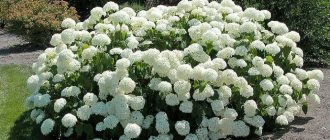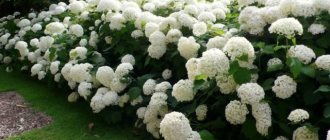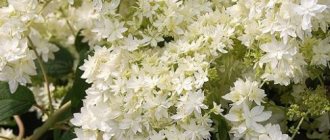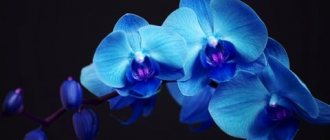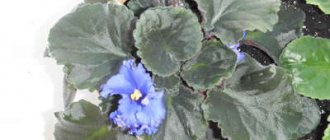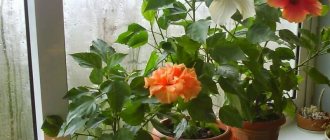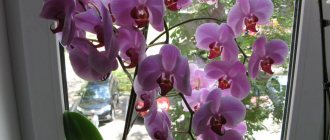Plants » Flowers
0
329
Article rating
Kira Stoletova
Among all the ornamental shrubs, Pink Annabelle hydrangea is one of the most popular plants. A relatively new variety, valued for its large inflorescences and good frost resistance, is grown everywhere. Let's look at what this crop looks like, how to plant and care for it correctly.
Hydrangea pink Annabelle
general characteristics
The variety is fast-growing, frost-resistant, belongs to the group of tree-like hydrangeas. Botanical name: hydrangea arborescens pink annabelle. External description:
- bush with a spherical crown;
- the shoots are green, slightly pubescent, strong, erect, so the plant looks compact;
- leaves are emerald, oblong or ovoid with a sharp tip and jagged edges;
- The flowers are pink, small, collected in dense, large inflorescences with a circumference of 30 cm.
The culture is valued for its abundant flowering, which begins in June and ends in September.
Appearance and description of Pink Lady hydrangea
Pink Lady is a common variety of hydrangea (from the Latin Hydrangea Paniculata). A new paniculate variety appeared in the Kingdom of England in the 20th century. And since then it has become a favorite among gardeners, which is not surprising. A tall two-meter bush with wide spreading fan-shaped branches and voluminous flowers attracts the eye. The bright green flat leaves of hydrangea with small teeth along the edges give the plant a special appearance. The inflorescences resemble a cone and consist of two varieties of small bisexual flowers with a diameter of up to 3 cm. Thanks to the compact arrangement of the inflorescences, the bush acquires a voluminous regular shape.
What does Pink Lady hydrangea look like?
For your information! The sight of blooming hydrangea is mesmerizing. It is difficult to describe the color palette in words. This is a must see. Delicate nude shades give way to milky green, pale pink, and rich scarlet. As pollination occurs, some of the petals fall off.
Hydrangea blooms from July until frost, revealing all the beauty of the color. With proper care, bushes can please their owners for up to 10 years without replanting.
Description of the species
Hydrangea paniculata Pink Lady is a tree-like shrub with a plump crown. It sometimes grows up to 1.5-2 meters in height and up to 200 cm in volume. Its branches are decorated with large oblong dark green leaves framed with a carved edge. The tops of each branch are crowned with cone-shaped panicles of inflorescences. Inflorescences with a diameter of 15 to 30 cm are formed from small flowers on each individual stem.
Each individual flower consists of 4 round petals. They are so densely and closely located to each other that during the period of active flowering they create the effect of an air cloud emitting a sweetish aroma.
As they grow and develop, the buds change color, going through several stages: white in early summer, then light green, cream and soft pink in September. The flowering period of hydrangea lasts throughout the summer months, and sometimes until the first frost. Such a large plant has not deep, branching roots. It takes root well and grows in different types of soil.
If all agrotechnical care rules are followed, the flower will not need to be transplanted to a new location for 10 years. Hydrangea tolerates winter frosts of 30 degrees well.
Interesting. To the listed positive qualities of an ornamental plant, you can add advantages: it preserves the bush and does not fall apart during flowering, rigid branches do not bend under the weight of voluminous inflorescences. About the rose hydrangea Lady flower, a description of these features can be found in every gardener's reference book.
Frost resistance, drought resistance
Hydrangea Pink Lady is a perennial shrub with high frost resistance. The bush is able to withstand ambient temperatures down to -29–30 °C. If the shoots freeze slightly, they quickly recover.
Pink Lady paniculate hydrangea is more sensitive to drought. The plant is moisture-loving, and lack of water negatively affects the quality of flowering and the number of flowers. During long periods without water, the shrub may dry out.
Landing Features
The success of growing hydrangea depends on compliance with the timing, planting rules and further care.
Disembarkation times vary depending on the region:
- in the south, in the Middle and Central zone - spring and early autumn;
- in areas with harsh climatic conditions - mid-spring (so that the bushes have time to take root and prepare for winter during the season).
Organization of the place
The plant prefers to grow in sunny places where there is good light in the morning and evening. When planting in the southern corner of the garden, it needs shading, because the leaves and flowers fade quickly.
You should not plant under the walls of a house, tall and spreading trees, where there is constant shade. At this point, the hydrangea stops growing, the leaves become pale, and the flowering is poor.
The soil is light, loose and highly acidic. When planted on alkaline soil, the foliage turns yellow; on calcareous soil, growth is retarded and the flowers do not bloom so abundantly and colorfully.
Preparation of planting material
You can purchase Pink Annabelle hydrangea in one of the specialized stores or nurseries.
The best material is considered to be seedlings 2-3 years old with closed roots (in an earthen coma or container). Such plants have a well-developed root system and crown. In addition, they take root faster and better after transplantation to the site.
When purchasing, carefully inspect the shoots and foliage - they should not be yellow, black spots, growths or mechanical injuries. If the leaves do not fall off when shaking, it means the plant is fresh.
The substrate is slightly moist, without mold or acidification on the surface.
Before planting, the root system needs to be trimmed a little to stimulate the development of new roots.
Landing technology
The planting site is prepared two weeks before the planned planting of seedlings - all garden debris and plant debris are removed, dug up, and leveled.
Pink Annabelle Hydrangea
Dig holes slightly larger than the size of the root system. Approximate dimensions are 55x50 cm. Drainage (pebbles, crushed stone or screenings) is placed at the bottom to ensure good drainage of moisture from the roots. A nutritious composition of peat, leaf soil, humus and sand, mixed in equal quantities, is sprinkled on top.
The roots are lowered, straightened, covered with the remaining soil mixture, compacted, and watered. Consumption per bush is 10 liters of water. To prevent the soil from drying out, the tree trunk area is mulched with peat or humus.
When growing in groups, you should adhere to the 3x2 m pattern. This way, the plants will fully develop and there will be no competition for moisture and nutrients.
In the first two weeks, seedlings are very sensitive to sunlight and can quickly burn out. Therefore, during lunch hours they are shaded with agrofibre or burlap.
Preparing for winter
An adult plant has good frost resistance, so in regions with a warm climate there is no special need for its winter shelter, but in cooler regions it is necessary to cover the hydrangea. The young plant needs protection from winter cold in all regions of Russia.
Before covering the bush, you should clear it of dry leaves and damaged branches. After this, in the root zone of the plants, the soil is mulched with sawdust, and the bush itself is covered with spruce branches.
Protection
Hydrangea Pink Annabelle, the process of growing which is not particularly difficult, can become a decoration of any garden, regardless of its location. The main thing is to choose the right place to grow it and provide the plant with proper care.
Care requirements
Watering
Watering should be moderate but frequent:
- in summer - once a week;
- closer to autumn - once every 20 days.
Up to 20 liters are poured under one bush. Use settled water at room temperature.
The next day, the soil is loosened so that it allows moisture and oxygen to pass through well. Periodically remove weeds, which are an excellent breeding ground for pests and infections.
After this, mulch with a thick layer of peat to protect the soil from drying out quickly.
Feeding
For high-quality and long-lasting flowering, this shrub needs nutrients. It is necessary to fertilize Anabel rosea hydrangea twice:
- in mid-March, mullein solution - 1:10;
- In the summer, before budding begins, a complex of mineral fertilizers is added - superphosphate, potassium nitrate and urea in a 2:1:1 ratio.
Additionally, the plant can be watered with fertilizer containing a high content of iron and magnesium. This will help prevent the development of chlorosis.
Trimming
The optimal time to carry it out is late autumn, when flowering ends and the plant sheds its leaves. Cut off dried inflorescences and branches that have been damaged by diseases and parasites.
Hydrangea tree pink anabel
Strong, faded branches are cut to 5 cm in length, the rest are cut to the very base. This pruning will stimulate lush flowering next year and strengthen the remaining stems.
All procedures are carried out using a sharp and sterile instrument. The cut areas are treated with copper sulfate to avoid infection.
Care during the flowering period
The main task of the gardener is to achieve the longest flowering possible. The plant continues to be watered, loosened the soil, and buds that have already bloomed are removed.
Nutrition is not carried out during the flowering period, because fertilizers, especially those with a high nitrogen content, inhibit the budding process.
Care after flowering
At the end of this process, the plant needs strength to recover in order to produce new buds and grow fully next year.
Compost or humus is added to the tree trunk area - consumption per bush is 5 kg. After this, abundant watering is carried out. They also cut out all non-viable parts that only take away nutrients and moisture.
Preparing for winter
Hydrangea Pink Annabelle has good winter hardiness and frost resistance, so it needs light insulation.
On the eve of the first frost, the branches are carefully bent to the ground, pinned, then sprinkled with fallen leaves. To prevent the shelter from being blown away by the wind, you can lay spruce branches on top.
Covering material is removed in the spring, when the snow has thawed and the threat of return frosts has passed.
Condition requirements
Let's find out in which place in the garden it is best to plant Pink Annabelle hydrangea and what requirements the soil must meet.
Location and lighting
Choosing a place for this plant is very important, because in inappropriate conditions, Pink Annabelle hydrangea is unlikely to be able to demonstrate all its beauty and lushness. The most important thing is to plant it in a well-lit place; growing it in the shade is extremely undesirable. However, the plant does not tolerate direct sunlight either. The best option, therefore, is an area with abundant but sparse lighting.
Pink Annabelle can grow in partial shade, but it will bloom actively and luxuriantly only with sufficient lighting. It is very good if the site is protected on the north side by a wall of a building, a fence, or some other natural or artificial shield.
You cannot plant hydrangea near powerful, large trees and shrubs, as such neighbors will create unnecessary shadow and draw all the moisture from the soil. Tree hydrangea is in dire need of water and, if there is not enough water, it grows and blooms poorly.
Temperature
Hydrangea Pink Annabelle can also be grown in cool weather conditions. It is tree-like plant varieties that are suitable for regions with harsh climates.
Air humidity
The plant is not too demanding on this parameter. However, protection from drafts is important for Pink Annabelle - the shrub does not tolerate cool breezes.
Soil Features
Tree hydrangea Pink Annabelle will feel great, develop well and bloom in loose, permeable, fertile and acidified soil. The best option is loamy soil that can retain moisture well. The soil should be nutritious and rich in humus. You can make the substrate more acidic and suitable for shrubs by adding peat to it.
It is important to immediately choose a permanent place for the hydrangea before planting. This plant categorically does not like transplants and tolerates them very poorly and is difficult to adapt.
Time to board
It is best to plant Pink Annabelle in spring in May or autumn in September. In spring, plant young plants with buds that have already formed but have not opened. In autumn there will be no buds on the seedling, but there should be buds.
Reproduction methods
For tree hydrangea, gardeners use several propagation methods.
Pink Anabel variety of tree hydrangea
Cuttings
Cuttings are cut in the fall during sanitary cutting. At the top of the stems, select the strongest branches with several leaves and buds. The shoots of the current year that have not bloomed have the best survival rate. The optimal length is 15-20 cm.
In the lower part, all foliage is removed, then dipped in one of the growth stimulants for an hour. After this time, they are planted in a light, loose and well-moistened mixture of peat and sand. Planting depth is 3-4 cm. Each cutting is covered with half a transparent plastic bottle to create a greenhouse effect.
Before the onset of persistent cold weather, the seedlings are covered with burlap or agrofibre. When grown in a harsh climate zone, it is better to dig them up and transplant them into pots. In May, when the threat of return frosts has passed, it should be returned to its original habitat in the open ground.
Stem layering
Hydrangea pink anabelle successfully reproduces by layering. Choose an adult bush with good branching. A shallow trench (5-6 cm) is dug next to it. Sprinkle with a mixture of peat, sand and humus (1:1:1). Select the most flexible branch closest to the ground. Remove all the leaves on it, lower it horizontally into the groove, and pin it with staples. Sprinkle the branch with the remaining fertile soil and water it.
A week before persistent cold weather, cover with fallen leaves, pine sawdust or spruce branches. This will create additional protection against freezing in winter.
With the arrival of spring, when the snow thaws and the street heat stabilizes, the branch is dug up and cut off from the mother bush. Divide into several parts with roots, plant on the site according to the above described scheme.
Dividing the bush
This method is used for old plants that need rejuvenation. You can determine that a bush needs to be rejuvenated by its general condition - it stops growing, blooms sparingly, or does not produce inflorescences at all.
First, water the hydrangea abundantly, and after an hour, carefully dig it in to prevent injury to the roots. Remove and wash the root system under running water. Let it dry a little, then divide it into several parts with a garden shovel. It is important that each division has 2-3 shoots and roots left.
To avoid infection, the cut sites are treated with copper sulfate, and after drying, they are planted on the site.
Description
Tree hydrangea Pink Annabelle is the “sister” of the most popular Annabelle variety. But if Annabelle has snow-white flower caps, then Pink’s, accordingly, have pink ones. Note that the Annabelle variety is one of the oldest and most respected varieties of tree hydrangea. It was bred back in the 18th century in the USA and after several decades the plant spread throughout all the gardens of the world.
Appearance
The height of the shrub reaches one and a half meters, it grows quite spreading and powerful. Its shoots are powerful and strong, so even during the most active flowering period the branches do not bend to the ground. This way the shape of the bush is preserved: neat and compact.
The foliage of Pink Annabelle has a jagged shape characteristic of hydrangea; the leaves themselves are oval and turn yellow in the fall. The leaves in summer are bright green with a glossy shine, but closer to autumn they fade, turn yellow, and then completely fall off.
The flowers are pink, collected in huge, lush inflorescences, shaped like a ball. The diameter of such an inflorescence-ball can reach 30-40 cm. The color of the flowers of the plant is not entirely ordinary. The fact is that Pink Annabelle is able to change color: if at first the flowers are dark pink, then as they bloom they become lighter and brighter.
Functional Features
Flowers form only on young shoots, so the shrub requires complete pruning every year. The more the hydrangea is pruned in the fall, the more luxuriantly and actively it will bloom next season. The decorative period usually lasts from June to September. The shrub shows the best results on moist, fertile, loose and slightly acidic soils.
The flowering period of the plant is long - from the beginning of June to the end of August you can enjoy the magnificent view of the lush shrub. The plant is resistant to cold and is well adapted to the harsh Russian climate. The shrub can withstand frosts down to -40 degrees. However, young plants are not so hardy - the bar for them is set at -20 degrees, no lower.
In one place without transplanting or dividing, Pink Annabelle can grow for 50 years. And hydrangea grows very quickly: during the growing season the crown becomes 12-15 cm larger.
Application in landscape design
Pink Annabelle looks very impressive both in single and group plantings. The combination of this type of hydrangea with lilies, clematis, and roses looks impressive. It also looks advantageous as an edge for various flower and shrub compositions.
You can use the plant as an element of a hedge - such a landscape design will look very picturesque. The flower also looks great as a decoration for alpine hills, and looks gorgeous in compositions with rhododendrons and other types of hydrangeas. Pink Annabelle can decorate terraces, verandas and even balconies; its lush inflorescences are well suited for arranging bouquets and ikebana. Descriptions of various composition options can be easily found on the Internet.
In general, in the garden the plant looks extremely impressive, romantic and always appropriate. In addition, Pink Annabelle has a very pleasant aroma - light and unobtrusive.
Other types
The more famous subspecies of this group of hydrangeas is Annabelle. This is Pink Annabelle's closest relative, differing from her only in the color of the flowers. Annabelle's flowers are white, but depending on the composition of the soil they can change color.
Another famous variety is Strong Annabelle. This plant has such lush and multiple inflorescences that it is not always possible to see the branches behind them. Moreover, the flowering period is very long.
Diseases and pests
The Annabelle Pink variety rarely gets sick; a decrease in immunity is possible only if the rules of planting, care and maintenance are violated:
Hydrangea pink Anabel variety description photo
- Powdery mildew may appear on weakened bushes. It appears as a whitish coating, which becomes yellow-brown over time. Areas damaged by the fungus rot and die. Getting rid of this sore is not difficult - first you need to cut out the diseased areas, then irrigate the crown with copper-containing preparations (copper sulfate or Bordeaux mixture).
- The development of chlorosis occurs in hydrangeas growing on alkaline soil. With this disease, the foliage becomes pale, veins are clearly visible on the surface, and the bush stops blooming. To restore decorative properties, it is necessary to fertilize with fertilizers with a high iron content.
- Spider mite. Appears during periods of extreme heat and drought. It envelops the underside of the leaves in a fine web and sucks the juices out of them. Affected leaves turn yellow and fall off. For treatment, acaricides are used - Actellik or Aktaru.
To protect garden hydrangeas from diseases and pests, you must follow a number of simple measures:
- buy fresh and healthy seedlings;
- avoid crowding when planting;
- remove weeds and loosen the soil in a timely manner;
- provide regular hydration and nutrition;
- cut out diseased areas on the bush in a timely manner.
Planting hydrangea seedlings Anabel: step-by-step instructions
Using the recommendations for step-by-step planting of seedlings, you can quickly and correctly plant the Anabel tree hydrangea and avoid making mistakes:
- We dig holes 60-65 cm deep. The diameter of the hole should be within 50 cm.
- A drainage layer (5-10 cm) based on gravel is laid on the surface of the bottom of the recesses.
- Fertile soil is poured onto the drainage layer.
- Pre-purchased cuttings with a ball of soil on the root system are planted in holes. Under no circumstances should the roots be allowed to bend.
- Cover the cuttings with fertile soil. We compact the soil tightly so that the soil does not sag.
- Fill the cuttings with 20 liters of water.
Planting a seedling in a portable flowerbed
Planting a seedling in a stationary flower garden
Application in landscape design
Hydrangea is suitable for creating different compositions in the garden:
Hydrangea anabelle pink
- the bush is planted singly in the center or along the edges of the garden, where it is necessary to create bright colorful landscaping;
- planted in groups in combination with varieties of tree hydrangeas of other colors;
- The shrub looks great surrounded by perennials - roses, junipers, dwarf fir;
- grown near gazebos and terraces;
- used in creating multi-level flowering compositions, planted in the background.
Rules for use in the landscape
Hydrangea is used more often than other flowers in landscape design. Tapeworm, mass plantings, screens, hedges, background plants - everywhere it is advantageous and effective.
Hydrangea tree anabel planting and care photo
In the first years of her life, Annabelle is not very decorative; she resembles a long-legged teenager with thin twig-like legs. Therefore, flowering annuals 15-20 cm high, with a shallow root system, are planted around it.
In the future, when the bush grows to the planned size, perennials that require the same growing conditions can be planted near the hydrangea:
- hosts;
- conifers;
- azaleas;
- heather.
And one more thing - Annabelle is good in pots! It will decorate the balcony/terrace with abundant flowering, full of charm, and will add volume to compositions of annual plants, often miniature ones. Her massive hats look especially impressive in tall narrow containers.
In 1930, gardener and poet Vita Sackville-West designed a white garden in Sissinghurst, England, based on white hydrangeas. Until now, this project is considered the standard of elegance, purity of sophistication...
In France, the Annabelle arb neighborhood is popular. Hydrangea with boxwood and Japanese maple.
Varieties of tree hydrangea
In our latitudes, varieties with white flowers are most often found in gardening. Moreover, during the flowering process, the shade changes from light green and greenish to snow-white. Tree hydrangeas are also called white bush hydrangeas, and the British nicknamed them snowy hills.
Hydrangea tree Annabelle
One of the most popular varieties is notable for its very large balls of inflorescences. They are significantly larger than average and grow up to 25 cm, which is why they sometimes lie down under their own weight. Shrubs grow up to only 1.5 m, but grow up to 3 m in width.
Hydrangea arborescens Pink Annabelle
A hybrid variety based on the tree hydrangea Annabelle is also called Invincibelle. This is the first variety to come in a soft pink hue and was voted one of the best new varieties in the 2010s. If you trim the bush in time after flowering, Pink Annabelle will bloom again in six weeks.
Hydrangea tree Strong Annabelle
Another hybrid based on the Annabelle variety is notable for its resistance to external conditions. Its shoots are more powerful, and large lush inflorescences do not lie down under their own weight. This hydrangea is not afraid of heavy rains and gusts of wind.
Hydrangea tree White House
The White House variety looks interesting thanks to its delicate creamy shade. An unusual feature is the structure of the inflorescences, because fertile flowers are hidden in the middle, and large sterile ones are at the edges. The shrub grows up to 1.4 m and goes well with other species.
Hydrangea tree Bounty
Bounty is one of the most light-loving varieties, so it feels good even without midday shade. It has very small snow-white flowers, collected in a large bouquet of inflorescences.
Popular articles Hydrangea on a standard in landscape design
Hydrangea tree Grandiflora
Tree-like Grandiflora is notable for its very long flowering. During this time, the flowers change color several times from light green to snow-white, and then warm cream. This is a large shrub that can grow up to 2.5-3 m, unlike its more compact counterparts.
Hydrangea tree Pink Pinkushen
One of the most unusual varieties is distinguished by the shape of its inflorescence. Here it is not spherical, but pyramidal, so this hydrangea will amazingly diversify the garden composition. Pink Pinkushen looks wonderful even when it fades.
Hydrangea tree Hayes Starburst
This is the first variety of tree hydrangea with large double flowers collected in large round inflorescences. Because of the texture of the petals, they seem even larger, although they already grow up to 25 cm with a small height of the bushes - about 1 m. Because of this, the shoots may not support the weight of the inflorescences.
Propagation of hydrangea Pink Annabelle
For the variety of tree hydrangea Pink Annabelle, several methods of propagation are possible: seeds, cuttings, division of rhizomes, layering. Thanks to this, you can plant the bush around the site without buying seedlings every time. The most common method is cuttings. There are special requirements for the vegetative shoot.
Propagation by cuttings
Hydrangea Paniculata Pink Lady - description
A cutting is a piece of shoot about 15 cm long, on which several pairs of buds are located. Cut off the shoot before the buds open, in early spring. For better rooting, the stem is cut at an acute angle. For 15 days it is placed in water or fertile soil for flowering plants. Plants take root at a temperature of 200, transplantation is carried out after 2 years.
Growing from cuttings
At the stage of bud formation, you need to take the lower shoot and press it to the ground. By regularly watering the stem, roots appear within a year. This section is then separated from the rest.
Dividing the bush
The hydrangea bush is overgrown with a root system, so you can separate part of the root along with the shoot and replant it separately. This is a risky undertaking.
Note! If you separate the system without taking precautions, you can damage the mother bush and it will begin to hurt
My experience growing pink tree hydrangea
One of the very first pink varieties, “Pink Annabelle” (Invincibelle), has been growing in my garden for about five years. I want to say right away that some gardeners have complaints about this variety in particular, as well as about all pink-flowered tree-like hydrangeas in general. They say that their color is not quite pink, but a strange shade of “wet cardboard”.
Of course, the color of such hydrangeas is somewhat different from the pink-crimson tones of large-leaved hydrangea; both the size and shape of the flower are different. However, these hydrangeas are truly pink in color, especially rich when in full bloom. Their shade is pleasant, and even when the inflorescences, like all hydrangeas, fade as they bloom, they have a noble, original pinkish color.
The only objective complaint I have about this variety is its thin, weak shoots. In principle, the classic old snow-white variety of hydrangea “Annabel” also has this sin and is often prone to falling apart, but if this hydrangea does not always need to be tied up, then with the pink-flowered one you cannot do without installing supports. Indeed, otherwise all her delicate pink caps will end up lying on the ground - her stems are very thin and delicate.
Otherwise, this hydrangea makes me very happy. It has slightly smaller leaves and flowers than "Annabelle", but this makes it look even more delicate. Due to the fact that its flowers are not too bright pink, but in noble shades, it fits very well into the style of my garden, without violating the moderate severity and without introducing excessive childishness into it. When her heads fade, for me she begins to look even more noble and stylish.
In terms of care, it is completely comparable to the white-flowered tree hydrangea, that is, it is very unpretentious, but it will also definitely require abundant watering during heat and drought, because it is not for nothing that the name “hydrangea” is translated as “a vessel with water.”
At the same time, pink-flowering hydrangea also cannot tolerate excessively wet soils and needs good drainage. But, oddly enough, when there was a flood one day at my summer cottage, the Pink Annabelle hydrangea was the only hydrangea that came out of it alive. Bushes of all other white-flowering varieties died literally before our eyes in a matter of days. But the pink one, although it was on the verge, still waited until the flood ended, and part of its bush remained alive. I managed to revive him after the water subsided. This situation allows me to conclude that pink-flowered varieties are slightly more resistant to high humidity than white ones.
Of course, I never covered the pink tree hydrangea for the winter, just like the white one. There was no need for this. She always came out of the winter quarters unharmed. At the same time, our dacha plot is strongly blown by winds, and in winter the temperature there regularly drops below -30 degrees.
The bush grows in partial shade in moisture-absorbing garden soil. I fertilize hydrangea once a season before flowering with soluble complex mineral fertilizer along with the rest of the inhabitants of the flower garden. To maintain moisture and slightly acidify the soil, I mulch the bush with sawdust and pine bark. I make sure to water regularly, especially during drought, otherwise the leaves and inflorescences immediately droop.
Popular articles Description of hydrangea variety Dentel de Gorron, planting and careThe flowering of hydrangea “Pink Annabelle” begins in July and continues until autumn; I cut individual inflorescences and use them for winter bouquets. My neighbors for the pink-flowered hydrangea are hostas with a white pattern on the foliage, as well as yew, which has noble dark green needles. This composition looks very stylish and is unpretentious due to the fact that all its members require approximately the same care and growing conditions.
Pink hydrangea flowers change color as they bloom. Lyudmila Svetlitskaya
Trimming
Shrub pruning is an important procedure that must be done annually. Shoots are pruned in early spring, in March, during sunny weather with positive air temperatures.
We carry out pruning using a clean and sharp pruning shears, and protect the wounds with garden ointment.
During the procedure, we remove damaged shoots and those that disturb the neat habit of the bush. Accordingly, we form the plant by cutting off thin branches above the ground, cutting off the side branches at the 3rd bud. Radical pruning of hydrangea will prevent excessive growth of the bush. Large inflorescences appear on pruned shoots.
We remove the inflorescences in the fall or allow them to remain on the bush until spring. Faded inflorescences look beautiful and can become a decoration for the winter garden. Suitable for dry bouquets.
Features of cultivation and care
Our heroine is light-loving, and therefore it is advisable to plant her in an area where there is a lot of sunlight. However, when growing the variety in the southern regions, it is preferable to place the flower in partial shade.
It is especially important to follow the recommendations for choosing soil for the luxurious beauty Pink Annabelle. The soil must be loose, fresh and highly fertile. Hydrangea does not tolerate calcareous soil. The culture grows well in slightly alkaline soils, but for growing Pink Anabel it is preferable to use an acidified substrate. In any case, you will get a luxuriantly flowering shrub, the main thing is to adhere to the basic rules for caring for the plant: abundant regular watering without waterlogging (this will ensure good flowering and large inflorescences), periodic fertilizing with complex mineral and organic fertilizer, loosening the soil around the bush, spring pruning (carry out before the onset of sap flow or at the very beginning of the leaf blooming phase).
Although the bush retains its shape, it is better to use supports and tie up the tree-like plant to be on the safe side. The crop is very rare, but can still be affected by viral and fungal diseases, as well as aphids.
Where to plant hydrangea?
One of the most important stages of preparation is choosing a place for further growth of this beautiful culture. How well it will take root depends on the correct location of the seedling. When choosing a landing site, try to follow the following recommendations:
- Wind protection. Drafts have a detrimental effect on hydrangea flowers: they fade faster.
- Distance from large bushes and trees. If you place a seedling too close to more powerful plants, it will suffer from a lack of moisture and nutrients, because the large roots of its neighbors will take them for themselves. The recommended distance between hydrangea and other crops is at least 2 meters.
- Good lighting. The seedlings thrive in sun and partial shade, although they can also tolerate shady places.
If we take into account all the nuances, it turns out that the most optimal location for hydrangea is near fences, fences and walls of houses. With this arrangement, in the first half of the day the shrub will bathe in the sun’s rays, and in the second half of the day the fence will create partial shade for the plant
The process of planting in open ground
Annabelle hydrangea has its own soil requirements. The plant prefers slightly acidic soil types; with a high alkali content, it is not able to develop normally and may die.
For your information! Lime and chalk interfere with the growth of the root system, which causes deformation and loss of foliage.
For alkaline soils, a mixture consisting of peat, sand, turf and sawdust taken in equal proportions is added to the planting holes. A plant planted with such nuances will need to be fed periodically.
The place on the plot should be away from trees and large crops. Otherwise, the hydrangea will not have enough water.
Planting work in the Moscow region is carried out in the spring, from late April to early May, the exact time depends on weather conditions. Mature shrubs 2-3 years old are suitable for planting. When growing crops in cold areas (in Siberia and the Urals), planting time is postponed to the first weeks of summer.
Planting work is carried out according to the following algorithm:
- Before planting, the root system is disinfected. The roots of the plant are immersed in a solution of potassium permanganate for 5-10 minutes.
- Holes measuring 40x40 cm and more than 50 cm deep are dug in the area. This ratio will allow the roots to develop normally and not feel constrained.
- When planting on depleted soils, use special soil, sold in flower shops. A self-prepared soil mixture does not guarantee the absence of parasite larvae and fungal infections.
- Places located in lowlands are additionally drained with a mixture of crushed stone and sand.
- After completing the preparatory activities, the roots of the bush are carefully spread along the bottom of the hole, and the voids are filled with soil. The upper section of the root system remains above the ground; the soil around the bush must be lightly compacted.
- The plant is watered with 1-2 buckets of water, the trunk circle is filled with mulch mixture. This will create the microclimate necessary for normal root development and will not allow moisture to evaporate too quickly.
Note! When creating hydrangea hedges, shrubs are planted at a distance of up to 2 m from each other. This is due to the further development of the plant, since, despite their small height, the bushes have a voluminous and spreading crown
Advantages and disadvantages
Tree pink hydrangea has a number of advantages that distinguish this flower from other garden plants. The following advantages of Pink Annabelle are highlighted:
- immunity to sub-zero temperatures - the variety easily tolerates frosts down to 35-40 C;
- seedlings do not require obligatory shelter for the winter;
- hydrangea bushes easily take root in any soil;
- if all care rules are followed, flowers grow very quickly;
- the plant does not need abundant watering;
- resistance to infections that often affect garden plants.
This variety has no disadvantages. If you want Anabelle hydrangea to delight you with its beautiful buds, plant the plant in open areas of the garden, reliably protected from drafts.
